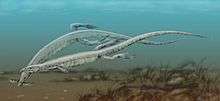Pleurosaurus
| Pleurosaurs Temporal range: Late Jurassic, 152–150.8 Ma | |
|---|---|
 | |
| P. goldfussi fossil specimen | |
| Scientific classification | |
| Kingdom: | Animalia |
| Phylum: | Chordata |
| Class: | Reptilia |
| Order: | Rhynchocephalia |
| Family: | †Pleurosauridae |
| Genus: | †Pleurosaurus Meyer, 1831 |
| Type species | |
| †Pleurosaurus goldfussi Meyer, 1831 | |
| Species | |
| |
Pleurosaurus is an extinct genus of diapsid reptiles belonging to the group Sphenodontia, extinct relatives of the modern tuatara. Pleurosaurus fossils were discovered in the Solnhofen limestone formation of Bavaria, Germany and Canjuers, France. It contains two species, P. goldfussi and P. ginsburgi.[1]

Restoration
Pleurosaurus is one of the few known aquatic sphenodontians. Its body was approximately 1.5 metres (4.9 ft) long,[2] and elongated for hydrodynamic streamlining, with comparatively short limbs and a powerful tail. It would have been able to swim rapidly, by undulating its slender body in a snake-like fashion. It had only small limbs, which probably did not aid in swimming, and nostrils placed far back on the head, close to the eyes.[3]
References
This article is issued from Wikipedia - version of the 11/14/2016. The text is available under the Creative Commons Attribution/Share Alike but additional terms may apply for the media files.